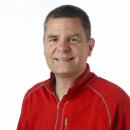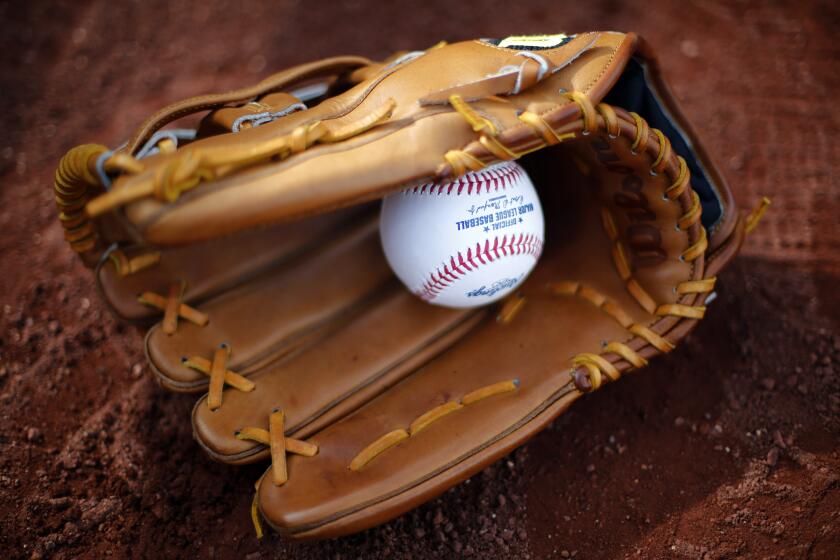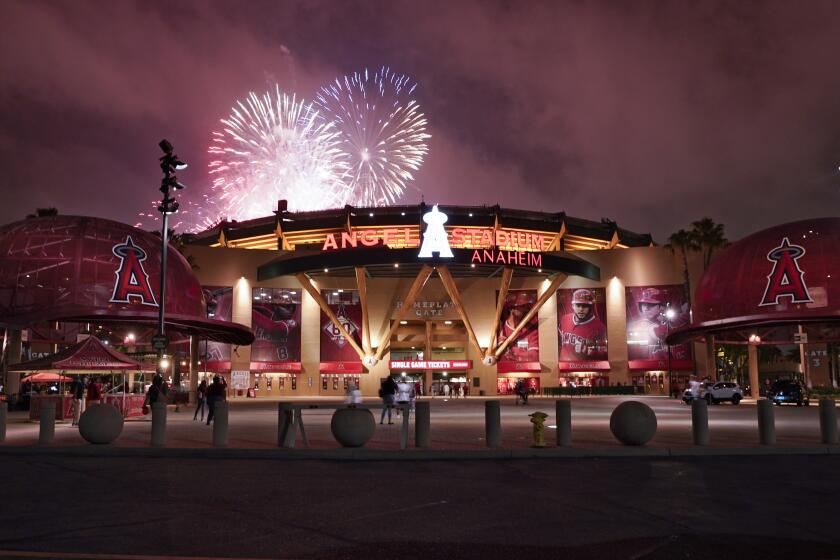U.S. Open 2021: A hole-by-hole look at Torrey Pines South
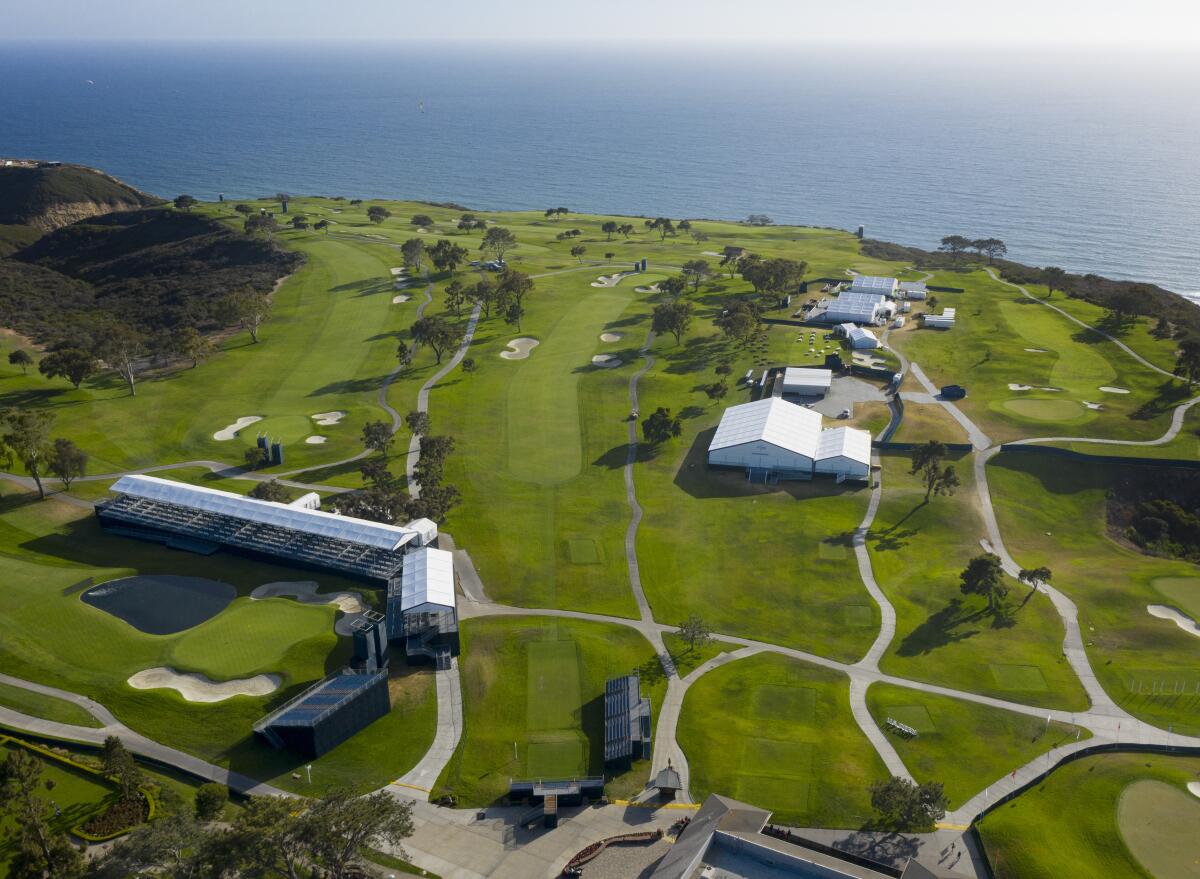
- Share via
The winning score at the Farmers Insurance Open at Torrey Pines in January, in the hail and wind, was 14 under par by Patrick Reed. Forty-seven players finished in red numbers.
The winning score there at the 2008 U.S. Open: 1 under. Players under par: two.
The Farmers plays one round at the easier North Course instead of all four at the South, as the 121st U.S. Open will this week. But otherwise, it’s the same course.
Sort of.
The U.S. Golf Association has spent years analyzing the South Course and devising mischievous, maniacal ways to make it harder, much harder. One way is playing it as a par 71 instead of par 72 by turning a par 5 into a par 4. Another is to grow the rough, harden the fairways, quicken the greens, tweak the tees.
The result? “It’s going to play like a different golf course,” 2020 Farmers champion Marc Leishman said in January.
“So much more difficult,” 2017 champion Jon Rahm said.
Here’s a hole-by-hole look at the monster that Torrey Pines South becomes for the U.S. Open, with analysis from someone who knows it as intimately as anybody. Chris Riley grew up in San Diego at Torrey Pines, played there on the PGA Tour, is the golf coach at USD and served as a consultant for the USGA this week to assist in course set-up.
Torrey Pines South Course
Par-71, 7,652 yards
2008 U.S. Open: Average score, 74.725
No. 1
Par 4, 446 yards
2008: 4.358, third hardest
This isn’t the most difficult hole on the course, but it ranks among the most difficult hardest opening holes anywhere on the PGA Tour. In 2008, Tiger Woods played the other 17 holes in 7-under and No. 1 in 6-over after recording three double bogeys.
Chris Riley: “The tee shot is critical to hit into the left center of the fairway to open up the second shot. It’s a slight dogleg right, so if you block it into the right bunkers off the tee, you’re almost certainly going to average over par on the hole.”
No. 2
Par 4, 387 yards
2008: 4.089, 15th
The shortest par-4 on the course offers a risk-reward proposition off the tee. Do you bomb it over the bunkers and get the roll down the hill, or lay back with an iron or hybrid to avoid the trouble? Staying below the hole is imperative on a radically sloped green. Go long? Good luck.
Riley: “The green is very tricky, so the main objective is just getting something in the fairway so you get can spin on your next shot. With how thick the rough will be, I imagine people will be hitting 3-irons off the tee.”
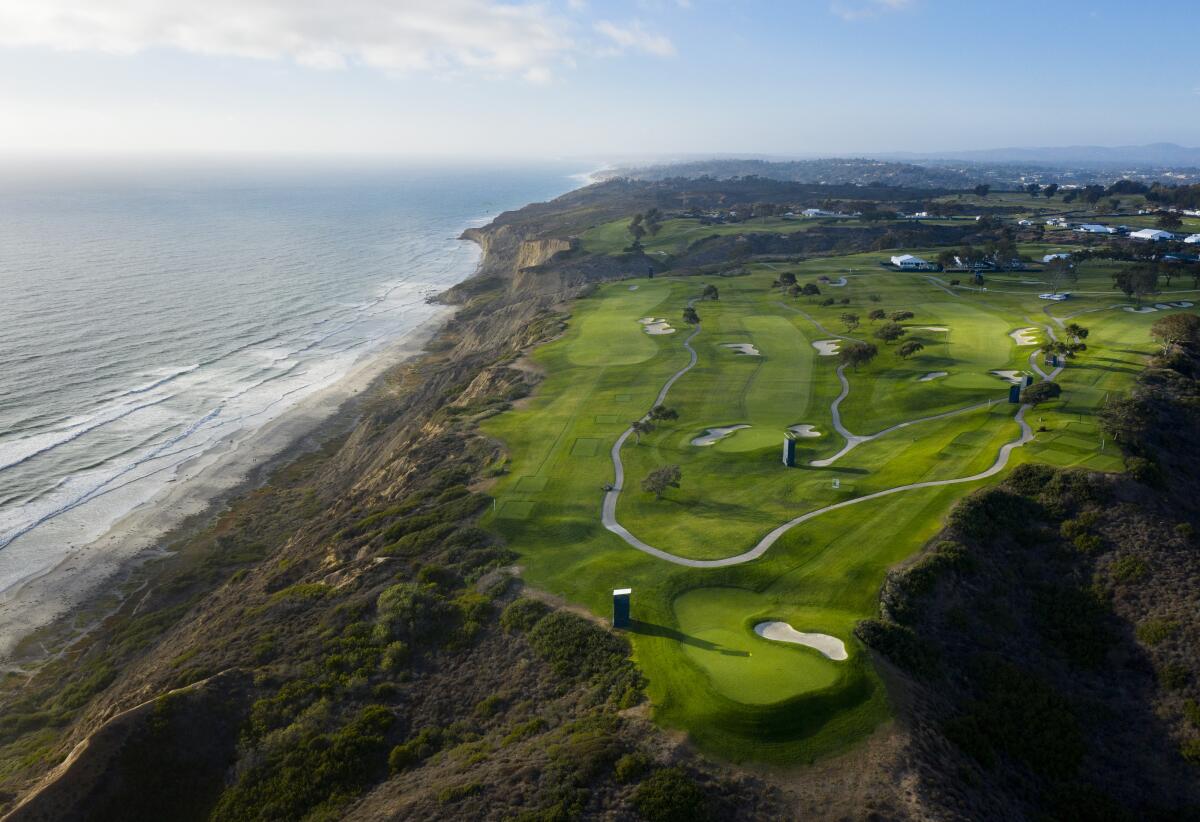
No. 3
Par 3, 195 yards
2008: 3.216, 11th
In the redesign before 2008, Rees Jones moved the green farther out onto the bluff, making it the most picturesque hole on the South Course with La Jolla in the distance. The USGA is expected to use multiple tee boxes and it could play as short as 130 yards, putting a premium on club selection. The conundrum: It’s downhill, so you club down; it’s also into the wind, so you club up.
Riley: “It depends on the hole location. Front left is the hardest, because it brings in the bunker and the canyon to the left. Back left is hard, too. I think most pros will try to hit the middle of the green. Par is a good score.”
No. 4
Par 4, 486 yards
2008: 4.284, sixth
The only hole that runs completely along the ocean. There are fairway bunkers only on the right because the cliffs penalize wayward balls on the left. A popular safety spot on approach shots is short right of the narrow green, which was reconfigured in the redesign.
Riley: “I think the hole is a little easier now. People can hit the ball to the right of the green into the slope, and it kicks back toward the green. But it’s still a really long hole. For the shorter hitters, it’s a par hole.”
No. 5
Par 4, 452 yards
2008: 4.159, 13th
It’s back to the formula of bunkers on either side of the fairway and green, demanding precision on first and second shots. The green is deceptively narrow, but otherwise it’s a fairly straightforward hole and a welcome respite between the fourth and sixth. In 2008, it had more birdies than any other par 4 on the front nine.
Riley: “I always stepped up there thinking I was going to make birdie. It’s not that hard a fairway to hit. The hardest hole location is back right because (from the fairway) it looks like it’s in the rough. Otherwise, I think we’ll see some birdies.”
No. 6
Par 4, 515 yards
2008: 4.507, second
This is a reachable, downwind par 5 during the Farmers Insurance Open that regularly ranks as the easiest hole with a scoring average around 4.5, meaning half the field birdies it as a par 5. That’s too easy for a U.S. Open, so they make it a par 4 but only shorten it by 45 yards.
Riley: “With how long the guys are now, it should be a par 4. Guys can hit over the canyon and make it even shorter. But that green is pretty severe for being a par 4, so I think it’s just get a par and get out of there. When courses design par-5 greens, in their mind people are hitting wedges into them so they make them harder. Now you’re hitting 5- or 6-irons into it, so it becomes very difficult.”
No. 7
Par 4, 460 yards
2008: 4.282, seventh
The No. 1 handicap hole on the public scorecard, largely because it plays only slightly shorter than the tournament tees. It is where the 19-hole playoff ended in 2008, after Rocco Mediate hit into the left fairway bunker and bogeyed. The green is guarded by a nasty bunker on the right and a chipping hollow to the left that seems innocuous enough but isn’t (pros save par from there only about half the time).
Riley: “You have to hit your drive into the left center, and that opens up the second shot in the dogleg right, especially when the hole location is back right. If you go right off the tee, you’ll get jammed and you won’t be able to get to that hole location. That’s also a par hole and get out of there.”
No. 8
Par 3, 173 yards
2008: 3.227, 10th
The shortest hole on the course, but caddies will earn their keep with club selection — wind at your back, hitting to an uphill green where you can only see the flagstick peeking over the front bunker. The green is no picnic, either, with ridges and undulations making shot placement imperative.
Riley: “When they put the pin on the back shelf, that back bunker is pretty much death. I wouldn’t say it’s a birdie hole when you walk up to it, but some people will make birdie there.”
No. 9
Par 5, 609 yards
2008: 4.923, 16th
This was lengthened in the latest facelift, with a cross bunker added to guard the front of the green and the grass shaved on the slope in the back. Which means: You might catch the cross bunker if you try to bounce up your second shot from the fairway, and you risk ending up in a challenging collection area if you land it on the green and it rolls over. Look for layups by everyone but the longest hitters.
Riley: “I still think this could be a birdie hole if the hole locations are gettable. I know it’s playing 600-plus, but it’s bombs away and there’s not that much trouble. The new cross bunker could come into play. That’s the hardest shot in golf, the 40-yard bunker shot, because you can skull it over the green or catch it fat.”
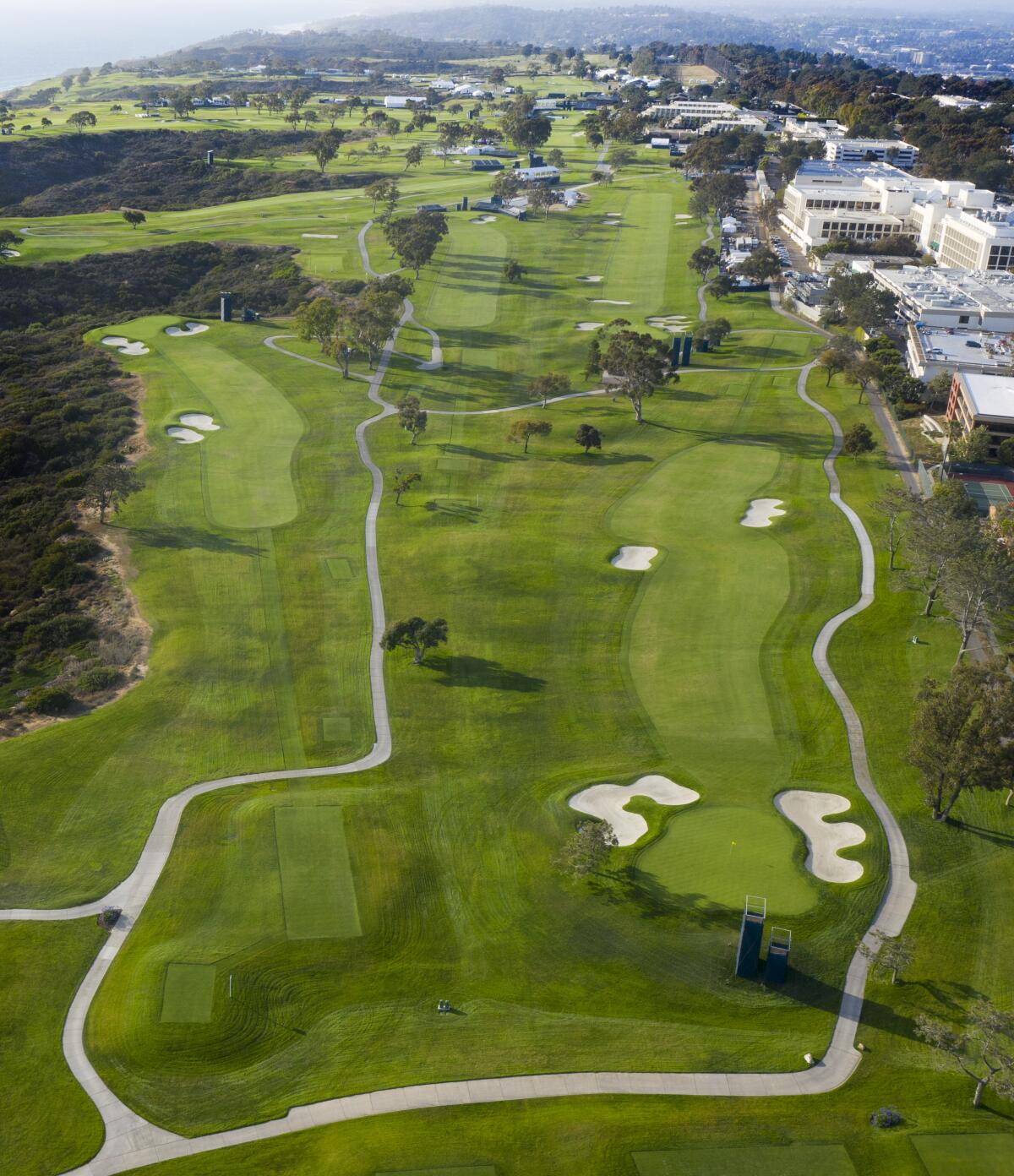
No. 10
Par 4, 449 yards
2008: 4.104, 14th
This also was lengthened but remains one of the easier, more benign holes on Torrey Pines South. It’s still short enough that players don’t need to hit to driver, increasing their chances of finding the fairway. The key is where the holes are cut.
Riley: “I wouldn’t say it’s a hard hole or an easy hole. It’s a classic Torrey Pines par-4 now. When it was shorter, it was definitely a birdie hole. Now it’s probably a par hole, especially if they put the hole locations up against the edges.”
No. 11
Par 3, 222 yards
2008: 3.310, fifth
This is the toughest par 3, with 158 bogeys or double bogeys in 2008 (the next most was 127 at the 16th). It’s long, dead into the wind, with a severely sloping green and bunkers surrounding it. Like most other par 3s at Torrey Pines, the USGA likely will use different tee boxes to change the yardage.
Riley: “The hole locations there are tough. It’s probably going to be a 5-iron, and that’s a pretty severe green for a par 3. It’s a pretty severe shelf on the back left. Everybody seems to hit it left into the bunker or the rough when they put (the hole) there.”
No. 12
Par 4, 501 yards
2008: 4.585, first
This is 14 yards shorter than the sixth hole but plays longer because it’s into the wind that propels the hang gliders drifting over the cliffs. Once you get there, the green is 35 yards deep, leaving some monster uphill or downhill putts. It annually ranks among the hardest holes on the PGA Tour (it was No. 1 in 2019), with only about one-third of players hitting the green in regulation. In 2008, it yielded just 15 birdies.
Riley: “You know what? If you make a 5, that’s OK, because you know half the field is going to be making a 5, too. The main thing is to get the ball in the fairway off the tee to give yourself a chance.”
No. 13
Par 5, 612 yards
2008: 4.855, 17th
The new tee box to the left makes it the longest hole on the course, requiring a 260-yard carry over the canyon and fairway bunkers. It’s the hilliest hole on a relatively flat layout, with a deep trench in front of the hole leaving an uphill shot to the green for those who lay up. Phil Mickelson took a 9 here in 2008 after his approach came up short and rolled back down the hill — three times.
Riley: “Probably only 20 guys will be able to reach it in two (shots). But it’s a birdie hole. Most guys will lay up to their number and try to wedge it to 10 feet. The biggest way you can get into trouble there is to hit it into the front bunkers and have the pin back right, leaving a long bunker shot.”
No. 14
Par 4, 434 yards
2008: 4.253, eighth
The tee was moved up to make this a drivable par 4 in 2008, but USGA officials say it will play its full length in 2021 because they don’t want to compromise the architectural integrity of the intended design. It’s a slight dogleg left wrapping around the canyon, with sightlines and the prevailing wind coaxing drives into the right rough. Beware of the flier lie from the rough and blowing your approach shot over the green — almost certainly a lost ball.
Riley: “Some guys will hit 3-iron or 3-wood off the tee. The tough pin position is when they put it back by the canyon, but then guys will club back to hit the middle of the green and try to make a 15- or 20-footer. The tee shot lines up straight into the rough, so 75 percent of the drives will be in the rough and it’s tough to make par from there.”
No. 15
Par 4, 480/513 yards
2008: 4.353, fourth
This is the only par 4 or par 5 without fairway bunkers, but they’re not needed because of the lengthened tee (it can play as long as 513 yards), the stand of eucalyptus trees on the left and some of the course’s nastiest rough on the right. Like 12, it ranks among hardest holes on tour (31st in 2019).
Riley: “There’s no trouble, but a lot of balls off the tee will go right because they’re afraid of hitting a hook and going into the hazard left or behind the trees. From the rough, you still have 200 (yards) in. With that back right pin location, you have to hit the fairway.”
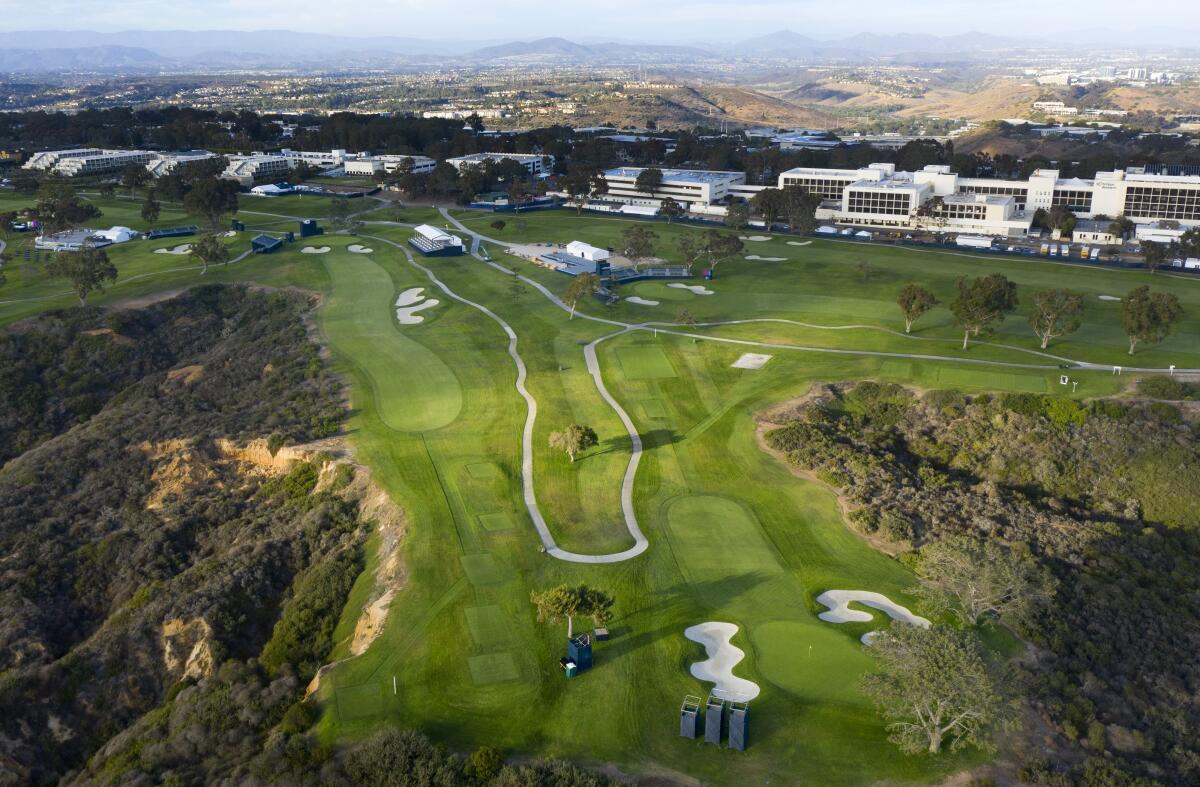
No. 16
Par 3, 223 yards
2008: 3.237, ninth
This is the third of the four par 3s that offer different tee options. One requires you to carry the canyon. The other is more uncomplicated but longer. Several hole locations, particularly back left, are inaccessible. Short birdie putts are a rarity.
Riley: “It’s like Billy Casper said: If you put it in the middle of the green on these par 3s, you’ll play them pretty well. Sometimes it’s hard when you’re that good to shoot it to the middle of green (instead of chasing flags), but in a U.S. Open you need that discipline.”
No. 17
Par 4, 440 yards
2008: 4.185, 12th
The new tee out on the cliffs gives the hole a completely different look. The fairway is narrower than it looks, and anything yanked left will flirt with the hazard. Despite being slightly uphill, it plays shorter than the yardage because of the tailwind off the ocean, meaning driver is not a must.
Riley: “You aim at those right bunkers and try to draw it off them. If the hole locations are gettable, it can be a birdie hole.”

No. 18
Par 5, 568 yards
2008: 4.790, 18th
After 17 grueling, grinding holes, you get a bona fide birdie — or even eagle — chance. Anyone who hits the fairway off the tee should have plenty of length to go for the green in two. The catch is they have to carry Devlin’s Billabong, the only water on the South Course. The Sunday pin for the Farmers is front left, requiring players to fly the ball past the hole and spin it back at the risk of sucking into the water. The USGA chose the easier front right location away from the pond for Sunday in 2008, resulting in arguably the most famous putt in U.S. Open history — the 12-footer that got Woods into a playoff with Mediate.
Riley: “If Rory (McIlroy) or Bryson (DeChambeau) stripe one down the middle, they’re going to have a mid-iron in. And the guys who can’t get there and lay up to their numbers, it’s a birdie hole as well. You put a wedge in the hands of the best players in the world, they’re going to make birdie a lot. I love having par 5s to finish, because there’s a lot that can happen.”
More to Read
Go beyond the scoreboard
Get the latest on L.A.'s teams in the daily Sports Report newsletter.
You may occasionally receive promotional content from the Los Angeles Times.



